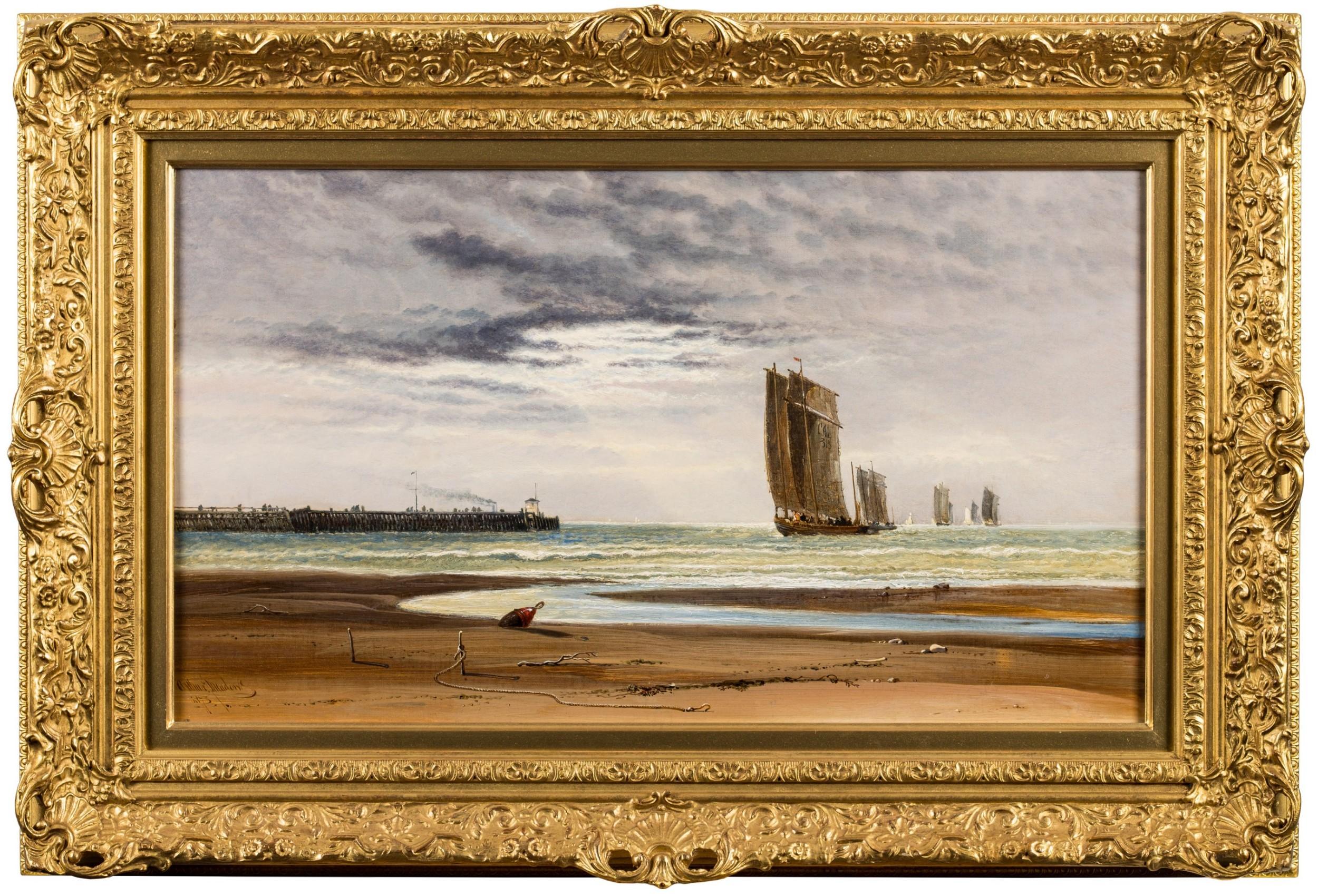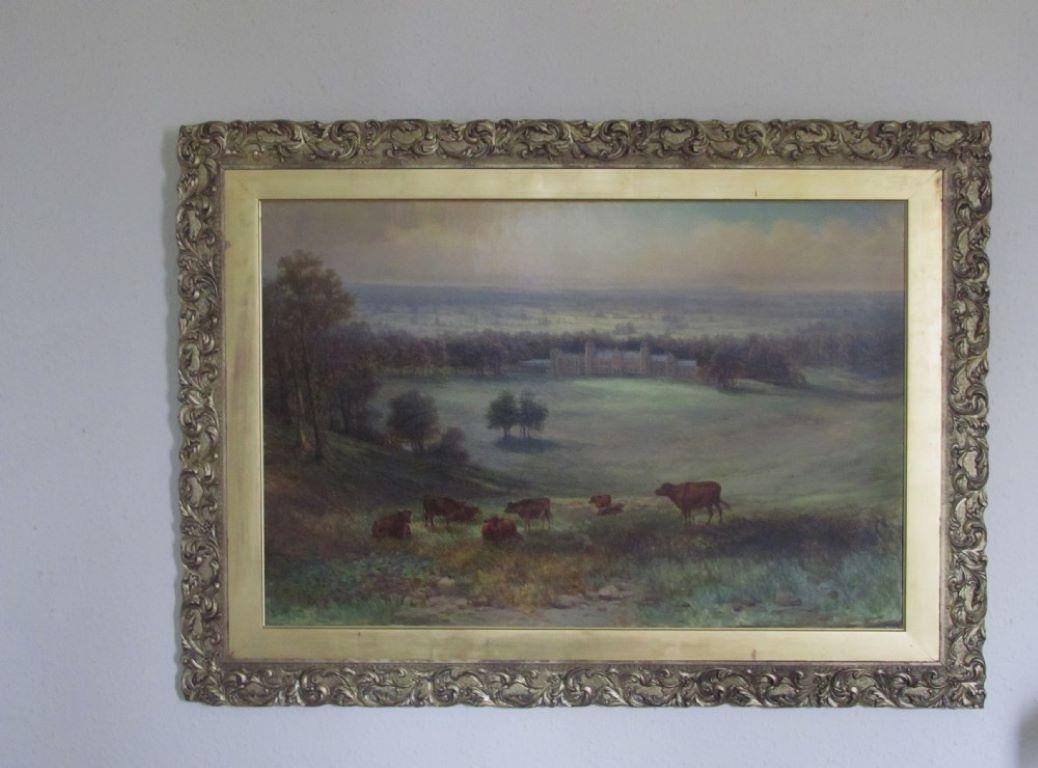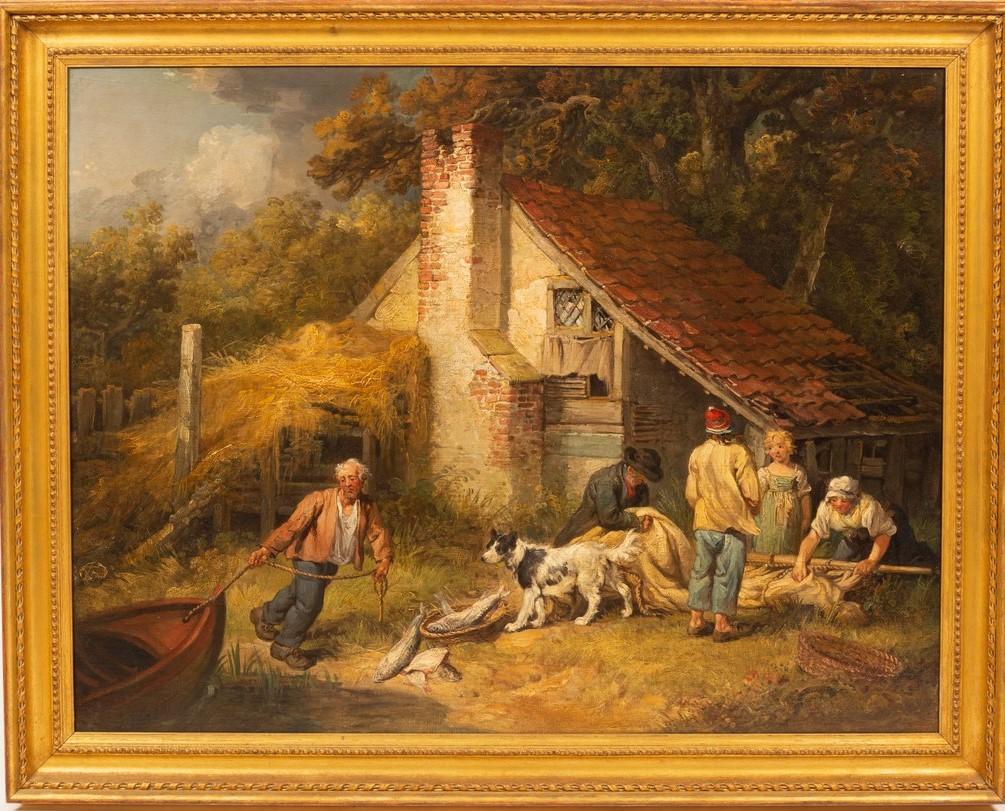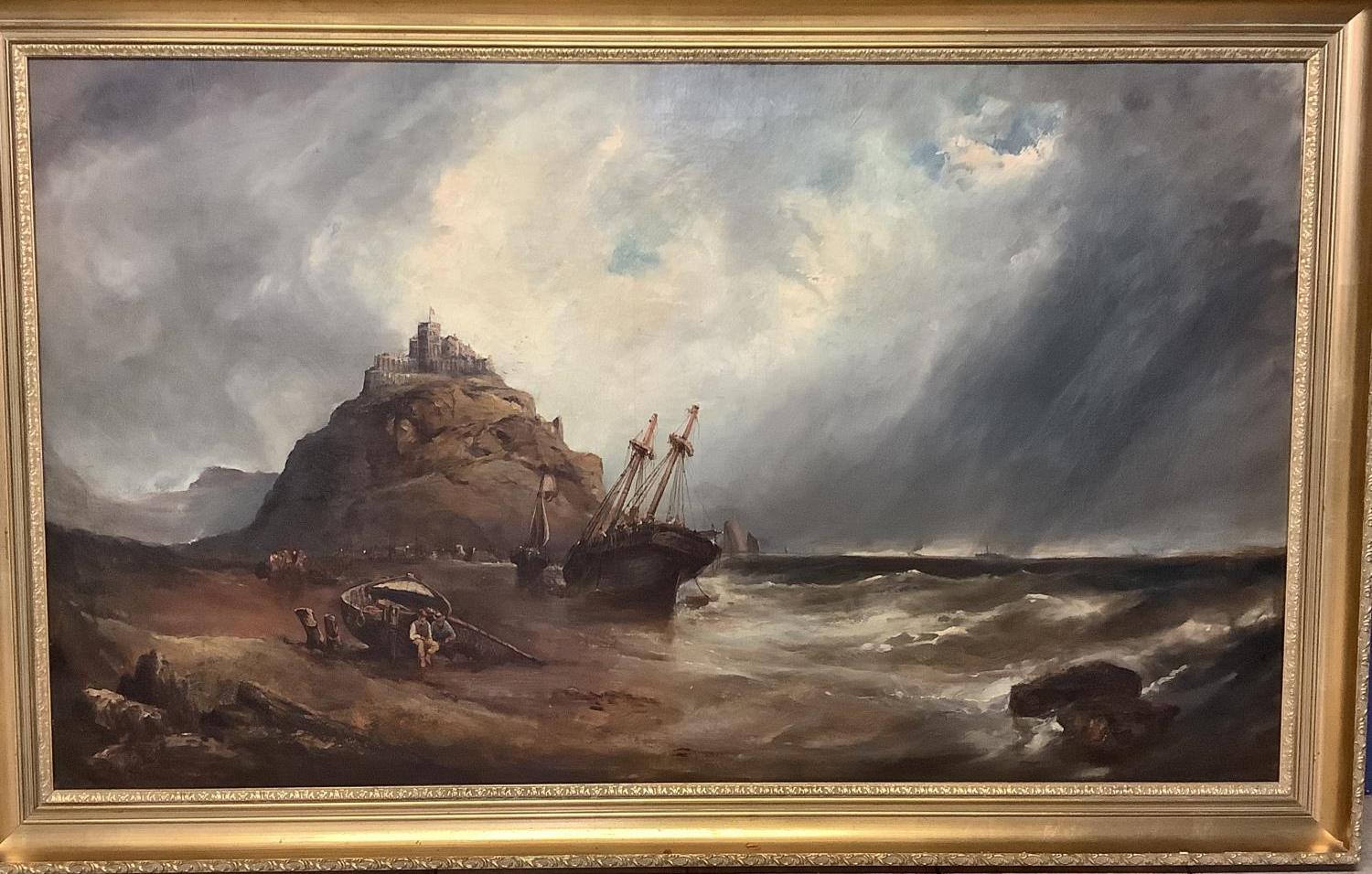Items Similar to Old Master Wooded Landscape - Irish 1830 art woodland oil painting
Want more images or videos?
Request additional images or videos from the seller
1 of 7
Old Master Wooded Landscape - Irish 1830 art woodland oil painting circa 1830
circa 1830
About the Item
A delightful large oil on canvas of a wooded landscape which dates to circa 1830 and is attributed to Irish artist James Arthur O’Connor. A superb painting and an excellent example of his work.
Provenance. Sotheby's London
Condition. Oil on canvas, 30 inches by 25 inches unframed and in good condition.
Housed in a fine carved frame, 38 by 33 inches framed. Very good condition.
James O'Connor was born in 1792, the son of William O'Connor, an engraver and print-seller who carried on business at No. 9 Exchequer Street, and, from 1791, at No. 15 Aston's Quay. James O'Connor, beyond some lessons he is said to have received from William Sadler (q.v.), was self-taught as an artist. His early works were compositions; his first studies from nature were made in the Dargle where he delighted in portraying its rocks and tangled foliage and rushing waters. In 1809 he commenced to exhibit, sending from 13 Aston's Quay an oil sketch, "Card-players," to the exhibition held in the Dublin Society's House in Hawkins Street. He continued to exhibit there until 1821, with the exception of the years 1816 and 1817, his contributions being mostly landscape compositions. In 1810 he published three etchings of figures, which were described in the "Hibernian Magazine" "as the first productions of a young and, as we have some reason to believe, a self-taught artist." He had formed a friendship with George Petrie and Francis Danby, to the latter of whom he had given some instruction in painting, and the three young artists determined to pay a visit to London. They arrived there in June, 1813; but their want of means made their stay a short one. Petrie returned to Ireland, and O'Connor and Danby set out on foot for Bristol where they arrived penniless. By the sale of some drawings Danby enabled O'Connor to return to Dublin; he himself remaining. On his return, O'Connor settled down as a landscape painter at 15 Aston's Quay, and later, in 1819, at No. 18 Dawson Street. He painted the scenery of Wicklow and the neighbourhood of Dublin, and in 1818 and 1819 was in the west of Ireland where he was patronized by Lord Sligo and Lord Clanricarde, for both of whom he painted a number of pictures of local scenery, views about Westport and Portumna. In 1820 he was awarded a premium of 25 guineas by the R.I. Institute. Though he worked hard he found but little demand for his pictures in Dublin; he had married, and, anxious to improve his prospects, he left Ireland and went to London. He began to exhibit at the Royal Academy the year of his arrival, 1822, and found some sale for his works. He continued as a constant exhibitor both at the Academy and at the British Institution until 1840, and also at the Society of British Artists, of which he was a member. He contributed to the Royal Hibernian Academy only twice, in 1836 and 1840; but a number of his works were exhibited there in 1842 and 1843, after his death. In 1826 he went to Brussels where he remained a year, and was successful in disposing of many of his pictures. In 1832 he was in Paris where he stayed eight months, leaving in May, 1833, when, accompanied by his wife, he visited Chalons, Saarbruck, Saarlouis and Metlach, and thence to Treves and down the Moselle to Coblentz and on to Mayence and Frankfort, returning to London in November, 1833. During this tour he painted some of his best pictures. In London he laboured incessantly, but with small success. He suffered from weak sight, and in 1839 his health began to fail. His inability to work involved him in pecuniary embarrassments, and, after a life of struggle and disappointment, he died in humble lodgings at No. 6 Marlborough Street, College Street, Brompton, on 7th January, 1841. He left a widow unprovided for. A subscription, headed with twenty guineas from the Prince Consort, was started for her benefit in 1845. O'Connor was a painter of deep feeling; his landscapes are solidly and vividly executed and are good in tone and colour. He was happy in the delineation of wild scenery and richly wooded landscapes, often with early morning or moonlight effects, in which he excelled. He was fond of introducing small figures in red coats or dresses into his landscapes. Most of his work was in oil, but he occasionally worked in water-colour. His works are housed in many National Collections.
- Attributed to:James Arthur O'Connor (1792 - 1841)
- Creation Year:circa 1830
- Dimensions:Height: 33 in (83.82 cm)Width: 38 in (96.52 cm)Depth: 2 in (5.08 cm)
- Medium:
- Movement & Style:
- Period:
- Condition:
- Gallery Location:London, GB
- Reference Number:1stDibs: LU853113392492
About the Seller
5.0
Platinum Seller
These expertly vetted sellers are 1stDibs' most experienced sellers and are rated highest by our customers.
1stDibs seller since 2018
398 sales on 1stDibs
Typical response time: <1 hour
- ShippingRetrieving quote...Ships From: London, United Kingdom
- Return PolicyA return for this item may be initiated within 14 days of delivery.
More From This SellerView All
- Ships Heading to Sea - Dutch 17th century Old Master marine art oil paintingLocated in London, GBThis fantastic Dutch Old Master marine oil painting is by noted Dutch marine artist Abraham Storck. Painted circa 1670 the composition is a number of ships heading out to sea, their ...Category
1670s Old Masters Landscape Paintings
MaterialsOil
- Wooded Landscape with Diana Hunting - 17thC Old Master French art oil paintingBy Jean François MilletLocated in London, GBA original large French Old Master oil on canvas which is by Millet (1642-1679) and was painted circa 1675. This large canvas is in good clean condition and depicts a wooded landscap...Category
17th Century Old Masters Landscape Paintings
MaterialsOil
- Travellers near Ruins in a Landscape - Dutch Old Master art figural oil paintingBy Pieter WouwermanLocated in London, GBThis lovely Dutch Old Master oil painting is attributed to artist Pieter Wouwerman. Painted circa 1660 it is figurative landscape with horseback travellers and their dogs in the foreground approaching ruins on their left. Beyond is a river snakes through the landscape, beneath the fading light of approaching dusk. There are some superb details making this an excellent Dutch Golden Age oil painting...Category
Mid-17th Century Old Masters Landscape Paintings
MaterialsOil
- Villagers in a Landscape - Flemish 17thC art figurative landscape oil paintingLocated in London, GBThis fantastic Flemish 17th century Old Master oil painting is by Thomas Van Apshoven. It was painted circa 1650 and depicts a village with figures outside a tavern, eating, drinking and dancing. Beyond are more dwellings, villagers and animals, all under a blue summer's sky. The detail, brushwork and vibrant colouring are superb. This is an excellent example of Apshoven's work and a typical subject he loved to paint. Provenance. Leominster estate. Wax stamp verso. Condition. Oil on panel, 22 inches by 17 inches and in good condition. Frame. Housed In beautiful gilt frame, 30 inches by 25 inches and in good condition. Thomas van Apshoven (1622– 1664) was a Flemish painter known for his landscapes with peasant scenes and genre scenes in interiors. His genre scenes depict village festivals, the interiors of taverns, village scenes or landscapes with peasants engaged in various activities, singeries, guardroom scenes and laboratories of alchemists. Some still lifes have also been attributed to him. His themes and style are close to that of David Teniers the Younger. He was born on 30 November 1622 in Antwerp as the eldest son of Ferdinand van Apshoven the Elder and Leonora Wijns. His father was a painter who had studied with Adam van Noort and had become a master of the Antwerp Guild of Saint Luke in 1596. No paintings by his father are known. His younger brother Ferdinand van Apshoven the Younger became also a successful painter. Thomas studied under his father. Some sources state that he became a pupil of the prominent genre painter David Teniers the Younger. It is more likely, however, that he was an imitator of Teniers. He was registered as a 'wijnmeester' [son of a master] in the Guild of St. Luke of Antwerp in the guild year 1645–1646. He married Barbara Janssens on 22 March 1645. The couple had four children. The godfathers of the children included the painters Victor Wolfvoet...Category
1650s Old Masters Figurative Paintings
MaterialsOil
- Travellers and Dogs in Landscape, Ruins on Right - Dutch Old Master oil paintingBy Pieter WouwermanLocated in London, GBThis lovely Dutch Old Master oil painting is attributed to artist Pieter Wouwerman. Painted circa 1660 it is figurative landscape with horseback travellers and their dogs in the foreground with ruins on their right. Beyond is a river and hilly landscape, all in the fading light of approaching dusk. There are some superb details making this an excellent Dutch Golden Age oil painting. Provenance: Devonshire estate. Condition. Oil on canvas, 24 inches by 20 inches and in good condition. Frame. Housed in a complementary gilt frame, 31 inches by 27 inches and in good condition. Pieter Wouwerman (1623-1682) was a Dutch Golden Age landscape painter. He was born in Haarlem. According to Arnold Houbraken, a biographer of artists from the Dutch Golden Age, Pieter Wouwerman was the brother of the landscape painters Jan and Philips Wouwerman, who, like his more famous brother, made a living selling Italianate landscapes in the manner of Pieter van Laer...Category
Mid-17th Century Old Masters Landscape Paintings
MaterialsOil
- Morning Gun - British Old Master naval marine seascape ships art oil paintingBy Peter MonamyLocated in London, GBThis superb British Old Master marine oil painting is attributed to Peter Monamy. Painted circa 1730 it depicts Morning Gun - A morning gun is a gun fired at the first note of revei...Category
1730s Old Masters Landscape Paintings
MaterialsOil
You May Also Like
- Early oil depicting the Great Fire of LondonLocated in London, GBThe Great Fire of London in September 1666 was one of the greatest disasters in the city’s history. The City, with its wooden houses crowded together in narrow streets, was a natural fire risk, and predictions that London would burn down became a shocking reality. The fire began in a bakery in Pudding Lane, an area near the Thames teeming with warehouses and shops full of flammable materials, such as timber, oil, coal, pitch and turpentine. Inevitably the fire spread rapidly from this area into the City. Our painting depicts the impact of the fire on those who were caught in it and creates a very dramatic impression of what the fire was like. Closer inspection reveals a scene of chaos and panic with people running out of the gates. It shows Cripplegate in the north of the City, with St Giles without Cripplegate to its left, in flames (on the site of the present day Barbican). The painting probably represents the fire on the night of Tuesday 4 September, when four-fifths of the City was burning at once, including St Paul's Cathedral. Old St Paul’s can be seen to the right of the canvas, the medieval church with its thick stone walls, was considered a place of safety, but the building was covered in wooden scaffolding as it was in the midst of being restored by the then little known architect, Christopher Wren and caught fire. Our painting seems to depict a specific moment on the Tuesday night when the lead on St Paul’s caught fire and, as the diarist John Evelyn described: ‘the stones of Paul’s flew like grenades, the melting lead running down the streets in a stream and the very pavements glowing with the firey redness, so as no horse, nor man, was able to tread on them.’ Although the loss of life was minimal, some accounts record only sixteen perished, the magnitude of the property loss was shocking – some four hundred and thirty acres, about eighty per cent of the City proper was destroyed, including over thirteen thousand houses, eighty-nine churches, and fifty-two Guild Halls. Thousands were homeless and financially ruined. The Great Fire, and the subsequent fire of 1676, which destroyed over six hundred houses south of the Thames, changed the appearance of London forever. The one constructive outcome of the Great Fire was that the plague, which had devastated the population of London since 1665, diminished greatly, due to the mass death of the plague-carrying rats in the blaze. The fire was widely reported in eyewitness accounts, newspapers, letters and diaries. Samuel Pepys recorded climbing the steeple of Barking Church from which he viewed the destroyed City: ‘the saddest sight of desolation that I ever saw.’ There was an official enquiry into the causes of the fire, petitions to the King and Lord Mayor to rebuild, new legislation and building Acts. Naturally, the fire became a dramatic and extremely popular subject for painters and engravers. A group of works relatively closely related to the present picture have been traditionally ascribed to Jan Griffier...Category
17th Century Old Masters Landscape Paintings
MaterialsOil, Canvas
- Stag Hunting in the Vicinity of Nuremberg by a German Artist Peter von BemmelLocated in PARIS, FRThis small landscape shows a hunting scene: two riders are chasing a stag with their dogs at the edge of a forest. Signed by Peter von Bemmel, it is typical of the production of this...Category
1720s Old Masters Landscape Paintings
MaterialsCopper
- Arthur Joseph Meadows 19th Century Seascape Off CalaisBy Arthur Joseph MeadowsLocated in York, GBA very fine painting by the renowned seascape painter Arthur Joseph Meadows,Off Calais; fishing fleet returning at low tide. Housed in an antique style gilt frame the size overall is...Category
19th Century Old Masters Landscape Paintings
MaterialsOil
- 19th Century, Victorian, landscape , cows , Country House Samuel Lawson BoothLocated in York, GBS Lawson Booth : Country House in extensive landscape with cattle in the foreground, oil on canvas signed and dated '98, 60cm x 90cm (35x23 inches approx image) size with frame appro...Category
19th Century Old Masters Landscape Paintings
MaterialsOil
- James ward landscape oil Bringing in the CatchBy James WardLocated in York, GBJames ward landscape oil Bringing in the Catch A charming scene of a family "bringing in the catch" showing figures outside a cottage, man pullng in the boat with his dog watching by...Category
19th Century Old Masters Landscape Paintings
MaterialsOil
- St Michael's Mount, Cornwall Seascape OilLocated in York, GBThis early 20th century oil on canvas depicts a nautical scene with a view of St Michaels Mount beyond. Although as yet, not attributed to a particular artist,this painting has cl...Category
Early 20th Century Old Masters Landscape Paintings
MaterialsOil





